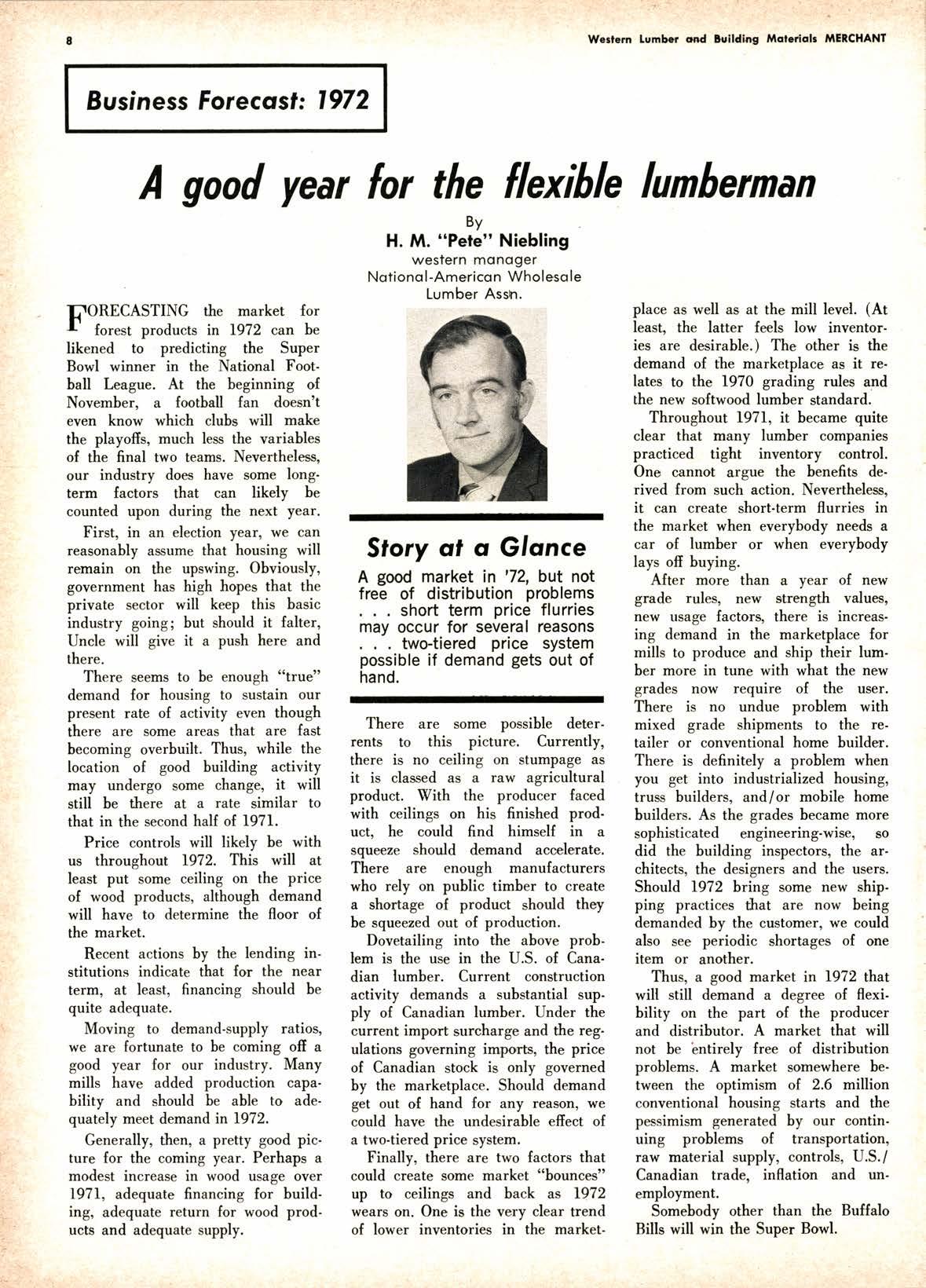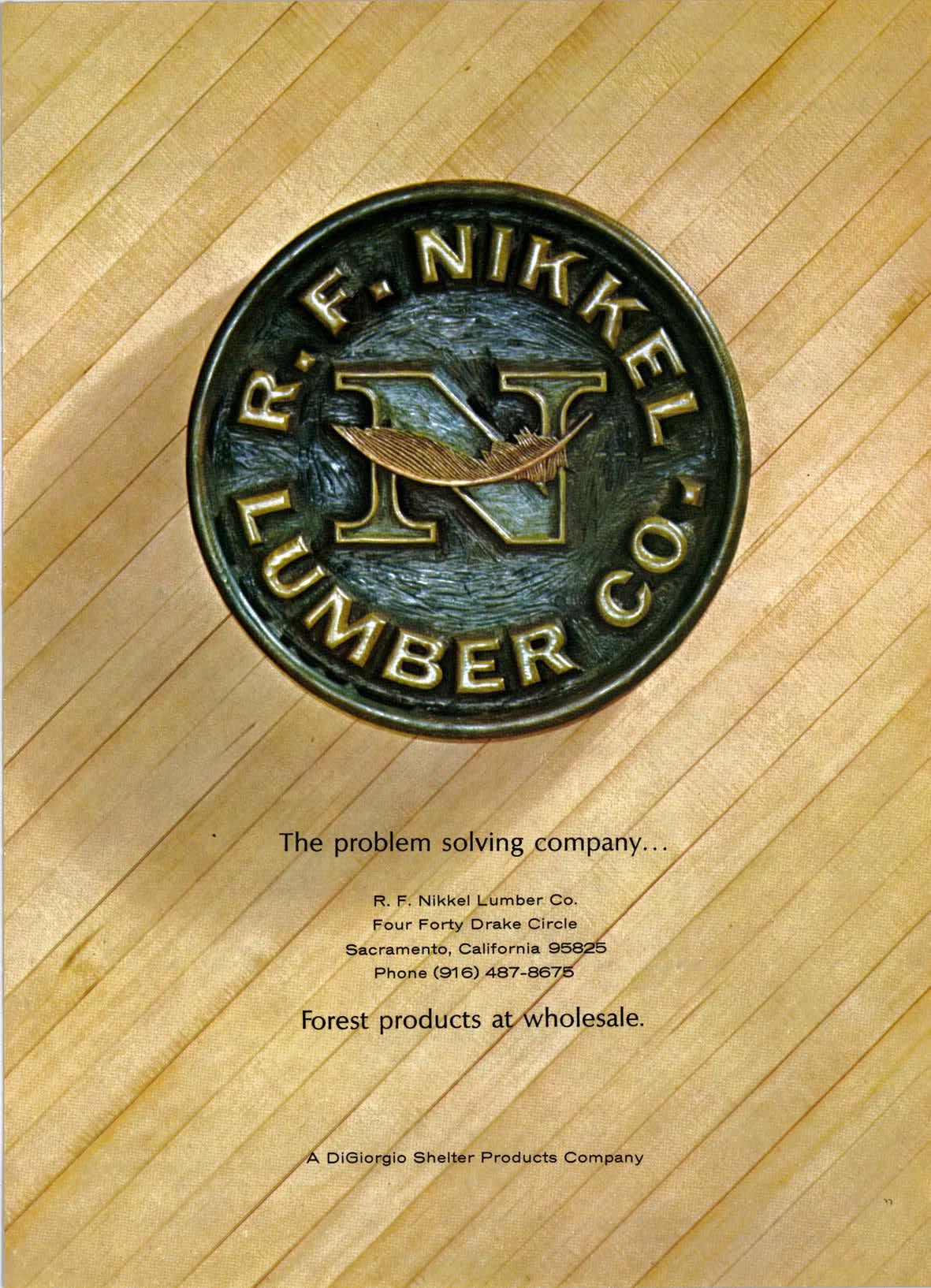
3 minute read
Business Foreccrsf: 1972 A good year for the flexible lunhernan
By H.,ln. "Pele" Niebling western monoger Notionol -Americon Wholesole Lumber Asstrr.
FORECASTING the market for l' forest products in 1972 can be likened to predicting the Super Bowl winner in the National Football League. At the beginning of Novernber, a football fan doesn't even know which clubs will make the playofrs, much less the variables of the final two teams. Neverthelesso our industry does have some longterm factors that can likely be counted upon during the next year.
First, in an election year, we can reasonably assume that housing will remain on the upswing. Obviously, government has high hopes that the private sector will keep this basic industry going; but should it falter, Uncle will give it a push here and there.
There seems to be enough tttrue" demand for housing to sustain our present rate o{ activity even though there are some areas that are fast becoming overbuilt. Thus, while the location of good building activity may undergo some change, it will still be ttrrere at a rate similar to that in the second half of 1971.
Price conrols will likely be with us throughout 1972. This will at least put some ceiling on the price of wood products, although demand will have to determine the floor of the market.
Recent actions by the lending institutions indicate that for the near term, at least, financing should be quite adequate.
Moving to demand-supply ratios, we are fortunate to be coming ofi a good year for our industry. Many mills have added production capability and should be able to adequately meet demand in 1972.
Generally, then, a pretty good picture for the coming year. Perhaps a modest increase in wood usage over l9?I, adequate financing for building, adequate return for wood products and adequate supply.
Story qI d Glonce
A good market in '72, but not free of distribution problems . . . short term price flurries may occur for several reasons . two-tiered price system possible if demand gets out of hand.
There are some possible deterrents to this picture. Curre,ntly, there is no ceiling on stumpage as it is classed as a raw agricultural product. With the producer faced with ceilings on his finished product, he could frnd himself in a squeeze should demand accelerate. There are enough manufacturers who rely on public timber to create a shortage of product should they be squeezed out of production.
Dovetailing into the above problem is the use in the U.S. of Canadian lumber. Current construction activity demands a substantial supply of Canadian lumber. Under the current import surcharge and the regulations gwerning irnports, the price of Canadian stock is only governed by the marketplace. Should demand get out of hand for any reason, we could have the undesirable efiect of a two-tiered price system.
Finally, there are two factors that could create some market ttbouncestt up to ceilings and back as 1972 wearr on. One is the very clear trend of lower inventories in the market- place as well as at the mill level. (At least. the latter feels low inventories are desirable.) The other is the demand of the marketplace as it relates to the 1970 grading rules and lhe new softwood lumber standard.
Throughout 1971, it became quite clear that many lumber companies practiced tight inventory control. One cannot argue the benefits derived from such action. Nevertheless, it can create short-term flurries in the market when everybody needs a car of lumber or when everybody lays ofi buying.
After more than a year of new grade rules, new strengtl values, new usage factorg there is increasing demand in the marketplace for mills to produce and ship their lumber more in tune with what the new grades now require of the user. There is no undue problern with mixed grade shipments to the retailer or conventional home builder. There is definitely a problem when you get into industrialized housing, truss builders, and/or mobile home builders. As the grades became more sophisticated engineering-wise, so did the building inspectors, the architects, the desigrrers and the users. Should 1972 bring some new shipping practices that are now being demanded by the customer, we could also see periodic shortages of one item or another.
Thus, a good market in 1972 that will still demand a degree of flexibility on the part of the producer and distributor. A market that will not be 'entirely free of distribution problems. A market somewhere between the optimism oI 2,6 million conventional housing starts and the pesimism generated by our continuing problems of transportation, raw material supply, controls, U.S./ Canadian trade, inflation and unemployment.
Somebody other than the Buffalo Bills will win the Super Bowl.










